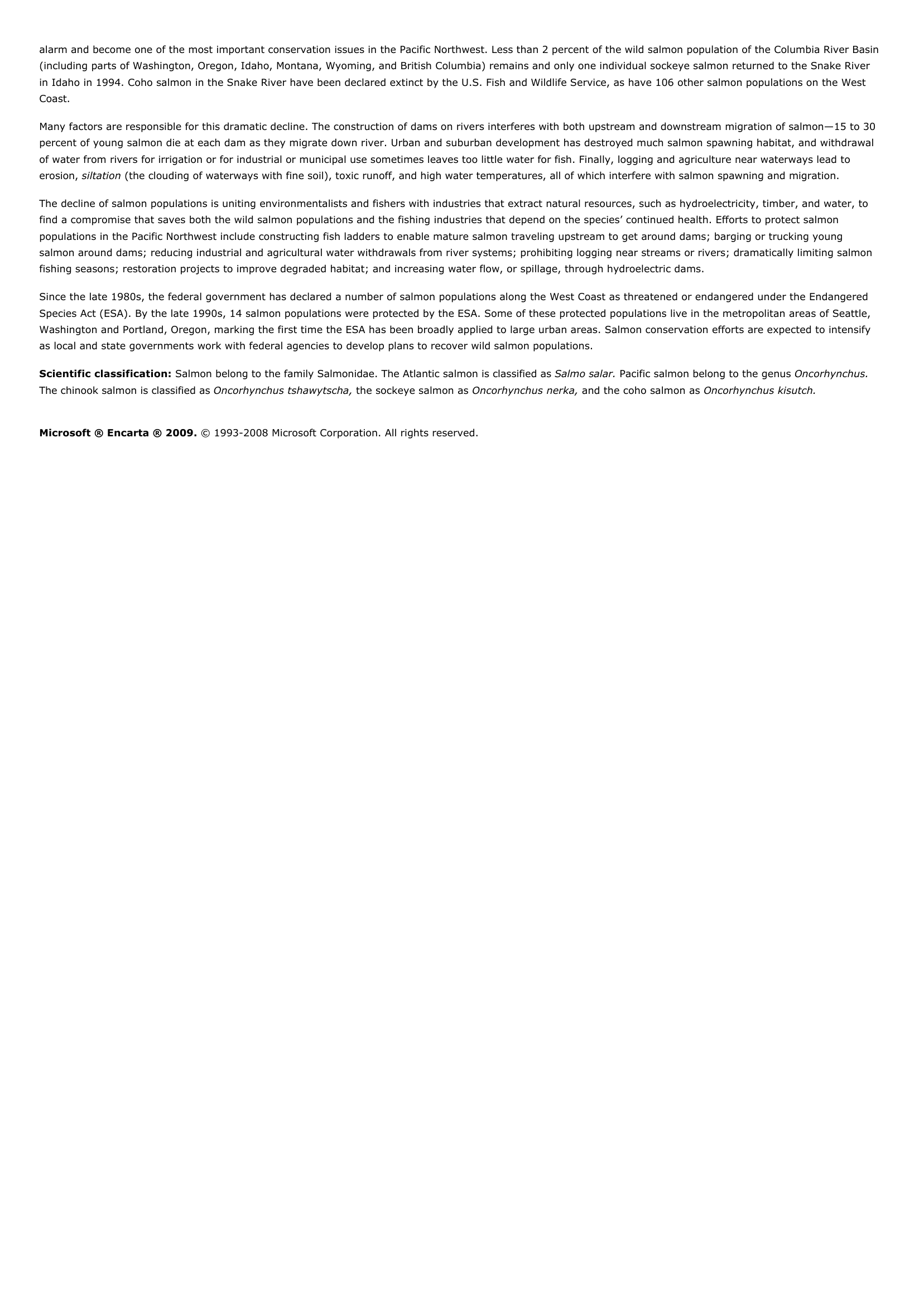Salmon (fish) - biology.
Publié le 11/05/2013

Extrait du document
«
alarm and become one of the most important conservation issues in the Pacific Northwest.
Less than 2 percent of the wild salmon population of the Columbia River Basin(including parts of Washington, Oregon, Idaho, Montana, Wyoming, and British Columbia) remains and only one individual sockeye salmon returned to the Snake Riverin Idaho in 1994.
Coho salmon in the Snake River have been declared extinct by the U.S.
Fish and Wildlife Service, as have 106 other salmon populations on the WestCoast.
Many factors are responsible for this dramatic decline.
The construction of dams on rivers interferes with both upstream and downstream migration of salmon—15 to 30percent of young salmon die at each dam as they migrate down river.
Urban and suburban development has destroyed much salmon spawning habitat, and withdrawalof water from rivers for irrigation or for industrial or municipal use sometimes leaves too little water for fish.
Finally, logging and agriculture near waterways lead toerosion, siltation (the clouding of waterways with fine soil), toxic runoff, and high water temperatures, all of which interfere with salmon spawning and migration.
The decline of salmon populations is uniting environmentalists and fishers with industries that extract natural resources, such as hydroelectricity, timber, and water, tofind a compromise that saves both the wild salmon populations and the fishing industries that depend on the species’ continued health.
Efforts to protect salmonpopulations in the Pacific Northwest include constructing fish ladders to enable mature salmon traveling upstream to get around dams; barging or trucking youngsalmon around dams; reducing industrial and agricultural water withdrawals from river systems; prohibiting logging near streams or rivers; dramatically limiting salmonfishing seasons; restoration projects to improve degraded habitat; and increasing water flow, or spillage, through hydroelectric dams.
Since the late 1980s, the federal government has declared a number of salmon populations along the West Coast as threatened or endangered under the EndangeredSpecies Act (ESA).
By the late 1990s, 14 salmon populations were protected by the ESA.
Some of these protected populations live in the metropolitan areas of Seattle,Washington and Portland, Oregon, marking the first time the ESA has been broadly applied to large urban areas.
Salmon conservation efforts are expected to intensifyas local and state governments work with federal agencies to develop plans to recover wild salmon populations.
Scientific classification: Salmon belong to the family Salmonidae.
The Atlantic salmon is classified as Salmo salar. Pacific salmon belong to the genus Oncorhynchus. The chinook salmon is classified as Oncorhynchus tshawytscha, the sockeye salmon as Oncorhynchus nerka, and the coho salmon as Oncorhynchus kisutch.
Microsoft ® Encarta ® 2009. © 1993-2008 Microsoft Corporation.
All rights reserved..
»
↓↓↓ APERÇU DU DOCUMENT ↓↓↓
Liens utiles
- Bass (fish) - biology.
- Fish - biology.
- Tropical Fish - biology.
- ENTREPRENEUR D 'ILLUMINATIONS (L’). André Salmon
- CRÉANCES (résumé) André Salmon










